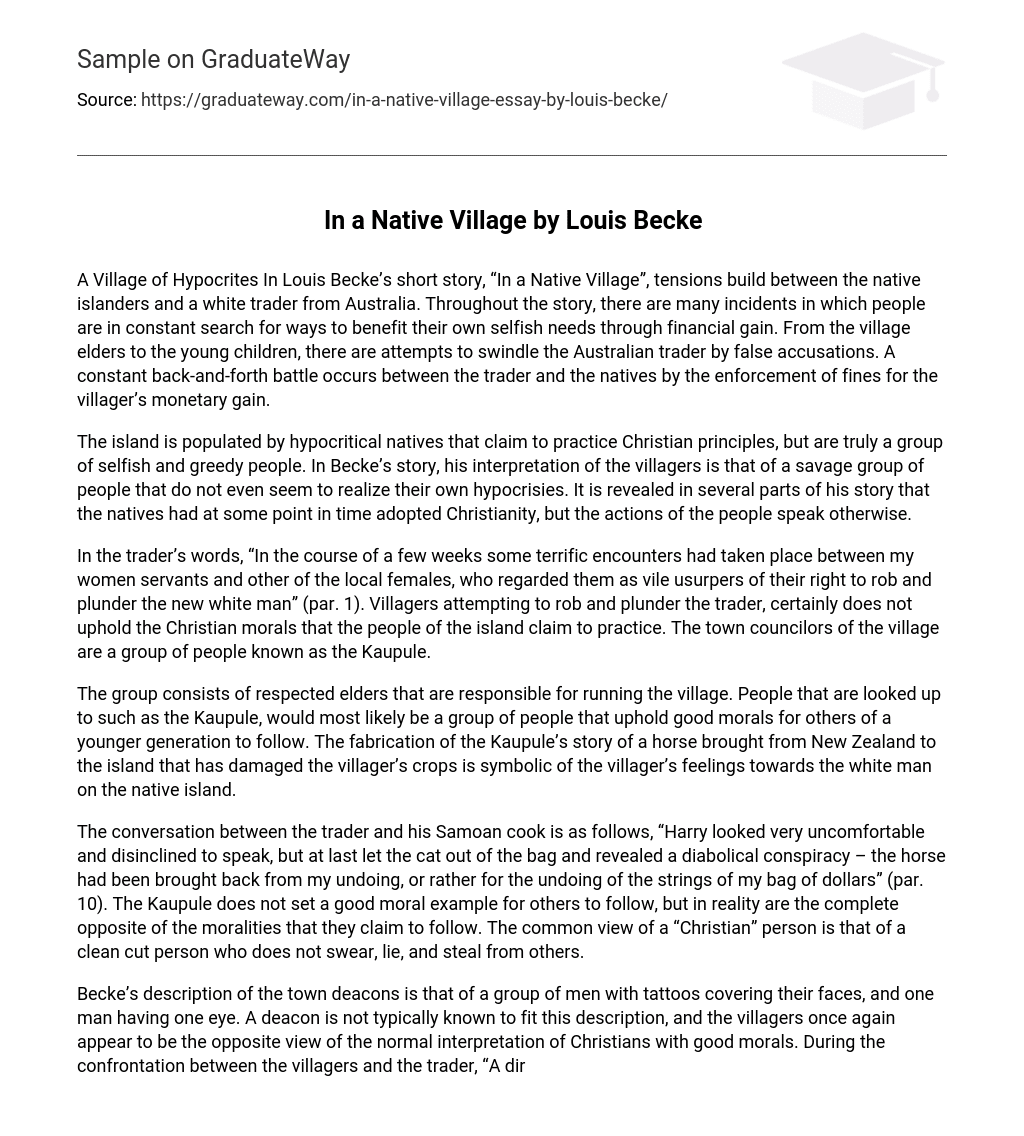” In a Native Village” by Louis Becke depicts a village where hypocrisy runs rampant. The tension between the native islanders and the white trader from Australia is palpable. Throughout the story, individuals seek ways to fulfill their selfish desires by gaining financial advantages. From the elders to the young children, everyone attempts to deceive the Australian trader through false accusations. Consequently, a relentless battle emerges between the trader and the villagers as fines are imposed to benefit their monetary gain.
According to Becke’s story, the island’s inhabitants are hypocritical, claiming to follow Christian principles but displaying selfishness and greed. The villagers are portrayed as savages who are unaware of their own hypocrisy. Despite having embraced Christianity in the past, their actions contradict their professed beliefs.
In the trader’s account, he states that there were several intense confrontations between his female servants and local females, who viewed them as intruders taking away the opportunity to exploit and steal from the new white man (par. 1). The villagers’ attempts to rob and plunder the trader contradict the Christian morals that the island’s residents claim to follow. The village’s governing body consists of individuals referred to as the Kaupule.
The village is managed by esteemed elders who hold the responsibility of leadership. Among them is the Kaupule, who is highly regarded and sets a moral example for the younger generation. The fabricated tale about a horse from New Zealand damaging the crops reflects the villagers’ sentiments towards the presence of white individuals on their native island.
The trader conversed with his Samoan cook, where the latter reluctantly disclosed a diabolical conspiracy. This centered around a horse being brought back to ruin the trader and his finances. The Kaupule, although claiming to uphold certain moral values, actually portray the complete opposite. Rather than setting a good moral example for others, they display behaviors such as swearing, lying, and stealing.
The town deacons, as described by Becke, are a group of men with tattoos on their faces, including one man with only one eye. This is an unconventional depiction for deacons, challenging the traditional image of Christians with high moral standards. In the confrontation between the villagers and the trader, a ruffian with a tattooed face and one eye approached the trader and inquired in a husky voice if he was aware of the biblical story where Ananias and Sapphira were punished for lying (par. 19).
The deacon’s accusation of the trader for lying is ironic, considering that he himself is the one who is lying. It is also peculiar that these types of men would quote from the bible. According to Becke, the native islanders are portrayed as a selfish and greedy group, from the elders to the young children. It is likely that the morals exhibited by the Kaupule have influenced the behavior of the children. The trader’s pigs symbolize the foul and detestable actions performed by all the villagers in order to deceive the white trader. The pigs are used by the deceptive children as a means to steal money from the trader through lies.
Upon the return of the traders piglets by the children, the trader expresses his satisfaction by stating, “Glad to recover the squealing little wanderers at any cost, I gave each lying child a quarter-dollar” (par. 28). The trader acknowledges that the children exhibit the same deceitful and acquisitive characteristics as any other villager. The villagers themselves appear to form a covetous community, deceiving the trader in order to fund the construction of their church. It is paradoxical to resort to theft in order to obtain funds for a place of worship. This portrayal of the villagers by Becke paints them as extreme hypocrites.
According to the story, the trader recounts that his prized black Australian boar was covered in coral lime whitewash, which had been taken from a tub that the natives were using to paint the newly-built church walls. The one-eyed deacon later claimed that the unfortunate incident was a form of punishment directed at the trader. This suggests that the natives are unaware of the gravity of their treacherous actions, as they deceived the trader into unknowingly killing his own pig and the deacon attributed it to divine retribution against the white man.
Becke’s story is an interpretation of a large group of people who are dishonest, deceitful, and hypocritical, but fail to recognize their own faults. These individuals claim to practice “Christian morals,” but their actual values are completely opposite. The white trader in the story is merely a pawn in the islanders’ deceptive and manipulative tactics to achieve their desires. The entire narrative serves as an ironic depiction of a village where the villagers remain oblivious to their own hypocritical behavior.
Work Cited: Becke, Louis. “In a Native Village.” Classic Reader. Blackdog Media. 2010. Web. 27 Mar. 2012.





